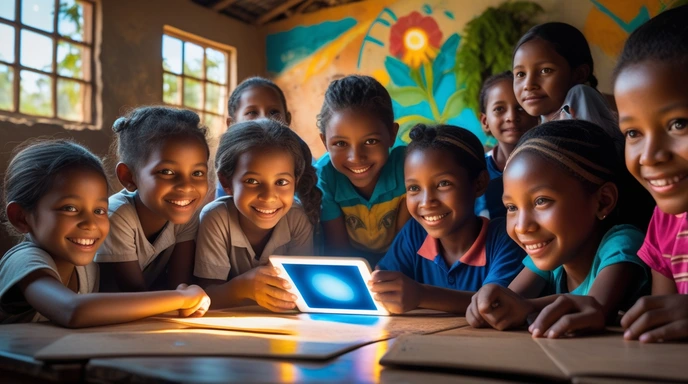The educational landscape is undergoing a significant shift, and at the heart of this change is EdTech (Educational Technology). This is particularly true for rural areas, where long-standing challenges related to access, resources, and qualified educators are being addressed through innovative technology. This article explores the critical role EdTech plays in bridging the educational gap, highlighting how it empowers students and teachers in underserved communities, fostering inclusivity and opportunities for all.
Table of Contents
Understanding the Educational Divide
Before we explore the transformative power of EdTech, it’s crucial to understand the underlying challenges that create the educational disparity between urban and rural areas.
The Unique Challenges of Rural Education
Rural schools often face a unique set of hurdles that impede access to quality education. These challenges include:
- Limited access to resources: 📚 This often means a lack of up-to-date textbooks, library facilities, and laboratory equipment.
- Teacher shortages: 👩🏫 Rural areas often struggle to attract and retain qualified educators, resulting in high student-to-teacher ratios and inconsistent instruction.
- Geographic isolation: 🏞️ The remoteness of many rural communities can make it difficult for students to access educational opportunities, particularly higher education.
- Infrastructure issues: 🚧 Many rural schools lack reliable electricity, internet connectivity, and even basic amenities like clean water, further hindering the learning environment.
The Urban-Rural Learning Gap
These challenges contribute to a significant learning gap between urban and rural students. According to research, students in urban schools often outperform their rural counterparts by a margin equivalent to a full year of schooling, even when socioeconomic backgrounds are considered. This gap highlights the urgent need for solutions that can level the playing field and ensure equitable access to education for all students, regardless of location.
EdTech as a Bridge: Innovative Solutions
EdTech is stepping up to address these disparities, offering creative and effective solutions. Here’s how:
Expanding Access to Quality Resources
EdTech dramatically expands access to educational resources in rural areas. 🌐
- Digital Libraries: Students can access vast libraries of digital books, articles, and other learning materials online, overcoming the limitations of physical libraries.
- Online Courses: Platforms provide access to high-quality lessons, videos, and interactive learning activities. 👨🏫 This ensures that students can learn from expert educators, regardless of their geographic location.
- Multimedia Content: Animated videos, simulations, and e-books make learning engaging and easy to understand, catering to diverse learning styles.
Personalized Learning Experiences
One of the most significant advantages of EdTech is its capacity for personalized learning.
- Adaptive Learning: AI-powered platforms adjust the learning pace and content based on individual student needs, ensuring that no student falls behind.
- Self-Paced Learning: Students can learn at their own speed, allowing them to master concepts thoroughly and achieve their full potential.
- Interactive Learning: Gamified lessons and interactive activities make learning more enjoyable and effective, sparking curiosity and improving knowledge retention.
Empowering Educators in Rural Settings
EdTech also plays a crucial role in empowering educators in rural areas.
- Professional Development: 👩🏫 Online platforms offer training programs, allowing teachers to stay updated on the latest teaching methodologies and technologies, improving their effectiveness.
- Access to Resources: EdTech provides teachers with multimedia resources and tools to create engaging lesson plans and provide real-time feedback to students.
- Reducing Workload: Technology can help automate some of the administrative tasks for teachers, allowing them to focus on teaching.
Skill Development and Future Readiness
EdTech goes beyond traditional academic subjects, preparing rural students for the demands of the future.
- Coding and Digital Literacy: Platforms introduce students to coding, robotics, and other digital skills essential for a digital economy, preparing them for future careers.
- Vocational Training: Initiatives are offering vocational training in areas such as agriculture, handicrafts, and small-scale industries, equipping rural youth with practical, employable skills.
- Global Competitiveness: By providing access to these skills and resources, EdTech enables rural students to compete in a global job market.
Real-World Impact: EdTech in Action
Let’s look at some real-world examples of how EdTech is making a difference in rural education.
Mobile Learning Platforms
📱 In rural India, mobile learning platforms are transforming education by making high-quality lessons accessible to even the remotest corners of the country. These platforms utilize mobile apps and affordable data plans, offering downloadable content that works even with limited internet connectivity. These platforms also provide interactive features, and personalized learning experiences.
Interactive Digital Classrooms
💻 Initiatives like the Digital Classroom Project are installing solar-powered interactive whiteboards in schools lacking reliable electricity. These whiteboards create more engaging learning environments and help overcome infrastructure challenges. The project includes training for teachers on how to integrate these new tools effectively into their teaching practices.
Offline Learning Solutions
💾 EdTech companies are addressing the lack of consistent internet by providing affordable devices and downloadable content. For example, durable, solar-powered tablets preloaded with educational materials are being distributed to rural schools. Audio lessons are also being offered through basic mobile phones. These solutions ensure that learning continues regardless of internet availability.
Overcoming Hurdles and Ensuring Equity
While EdTech offers many opportunities, certain challenges must be addressed to ensure its success and equitable access.
Addressing the Digital Divide
🌐 The digital divide, which refers to the gap between those who have access to digital technologies and those who don’t, particularly affects rural communities. This gap is exacerbated by poor digital infrastructure and lack of reliable internet access in many rural areas. It is crucial to prioritize investments in broadband infrastructure to ensure that all rural areas have reliable access to high-speed internet.
Affordability and Accessibility
💰 The cost of devices, data plans, and EdTech platforms can be a barrier for many families in rural areas. It’s essential to ensure that EdTech solutions are affordable and accessible to all, through initiatives such as low-cost devices, and subsidies for internet access.
Digital Literacy for All
💻 It’s crucial to ensure that both students and parents have the digital literacy skills needed to effectively use and navigate digital resources. Training programs are essential to bridge this digital skill gap and empower communities.
Charting a Path Forward: Sustaining EdTech’s Impact
To maximize EdTech’s impact, it’s crucial to ensure its long-term success.
Collaborative Efforts for Success
The widespread adoption of EdTech in rural areas will require collaborative effort between government agencies, EdTech companies, and educational institutions.
- Public-Private Partnerships: 🤝 Partnerships between the public and private sector to develop innovative, sustainable, and affordable solutions.
- Government Support: Government schemes and initiatives that fund EdTech implementation in rural schools.
- Community Engagement: Involving parents and local communities in the implementation and adoption of EdTech solutions.
A Brighter Horizon for Rural Education
EdTech has the power to transform education in rural areas, closing the educational gap and creating opportunities for every student, regardless of their location. By addressing the challenges, focusing on collaboration, and prioritizing equity, we can unlock the full potential of EdTech and build a brighter future for rural communities. The journey is ongoing, but the impact of EdTech is already making its mark, showing that every child, no matter where they live, deserves access to the best possible education. To learn more about a specific platform that is working towards making education more equitable and accessible in rural communities, explore Khan Academy’s official site.

